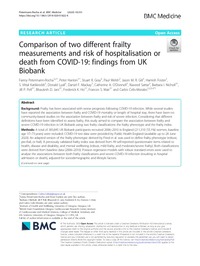Mostrar el registro sencillo de la publicación
Comparison of two different frailty measurements and risk of hospitalisation or death from COVID-19: findings from UK Biobank
| dc.contributor.author | Petermann-Rocha, Fanny | |
| dc.contributor.author | Hanlon, Peter | |
| dc.contributor.author | Gray, S.R. | |
| dc.contributor.author | Welsh, Paul | |
| dc.contributor.author | Gill, Jason M.R. | |
| dc.contributor.author | Foster, Hamish M. E. | |
| dc.contributor.author | Katikireddi, Vittal S. | |
| dc.contributor.author | Lyall, Donald | |
| dc.contributor.author | Mackay, Daniel | |
| dc.contributor.author | O’Donnell, Catherine A. | |
| dc.contributor.author | Sattar, Naveed | |
| dc.contributor.author | Nicholl, Barbara I. | |
| dc.contributor.author | Pell, J.P. | |
| dc.contributor.author | Jani, Bhautesh D. | |
| dc.contributor.author | Ho, Frederick | |
| dc.contributor.author | Mair, Frances S. | |
| dc.contributor.author | Celis-Morales, Carlos | |
| dc.date.accessioned | 2021-12-09T19:24:46Z | |
| dc.date.available | 2021-12-09T19:24:46Z | |
| dc.date.issued | 2020 | |
| dc.identifier.uri | http://repositorio.ucm.cl/handle/ucm/3540 | |
| dc.description.abstract | Background. Frailty has been associated with worse prognosis following COVID-19 infection. While several studies have reported the association between frailty and COVID-19 mortality or length of hospital stay, there have been no community-based studies on the association between frailty and risk of severe infection. Considering that different definitions have been identified to assess frailty, this study aimed to compare the association between frailty and severe COVID-19 infection in UK Biobank using two frailty classifications: the frailty phenotype and the frailty index. Methods. A total of 383,845 UK Biobank participants recruited 2006–2010 in England (211,310 [55.1%] women, baseline age 37–73 years) were included. COVID-19 test data were provided by Public Health England (available up to 28 June 2020). An adapted version of the frailty phenotype derived by Fried et al. was used to define frailty phenotype (robust, pre-frail, or frail). A previously validated frailty index was derived from 49 self-reported questionnaire items related to health, disease and disability, and mental wellbeing (robust, mild frailty, and moderate/severe frailty). Both classifications were derived from baseline data (2006–2010). Poisson regression models with robust standard errors were used to analyse the associations between both frailty classifications and severe COVID-19 infection (resulting in hospital admission or death), adjusted for sociodemographic and lifestyle factors. Results. Of UK Biobank participants included, 802 were admitted to hospital with and/or died from COVID19 (323 deaths and 479 hospitalisations). After analyses were adjusted for sociodemographic and lifestyle factors, a higher risk of COVID-19 was observed for pre-frail (risk ratio (RR) 1.47 [95% CI 1.26; 1.71]) and frail (RR 2.66 [95% CI 2.04; 3.47]) individuals compared to those classified as robust using the frailty phenotype. Similar results were observed when the frailty index was used (RR mildly frail 1.46 [95% CI 1.26; 1.71] and RR moderate/severe frailty 2.43 [95% CI 1.91; 3.10]). Conclusions. Frailty was associated with a higher risk of severe COVID-19 infection resulting in hospital admission or death, irrespective of how it was measured and independent of sociodemographic and lifestyle factors. Public health strategies need to consider the additional risk that COVID-19 poses in individuals with frailty, including which additional preventive measures might be required. | es_CL |
| dc.language.iso | en | es_CL |
| dc.rights | Atribución-NoComercial-SinDerivadas 3.0 Chile | * |
| dc.rights.uri | http://creativecommons.org/licenses/by-nc-nd/3.0/cl/ | * |
| dc.source | BMC Medicine, 18(1), 355 | es_CL |
| dc.subject | COVID-19 | es_CL |
| dc.subject | Coronavirus | es_CL |
| dc.subject | Risk factors | es_CL |
| dc.title | Comparison of two different frailty measurements and risk of hospitalisation or death from COVID-19: findings from UK Biobank | es_CL |
| dc.type | Article | es_CL |
| dc.ucm.indexacion | Scopus | es_CL |
| dc.ucm.indexacion | Isi | es_CL |
| dc.ucm.uri | bmcmedicine.biomedcentral.com/articles/10.1186/s12916-020-01822-4 | |
| dc.ucm.doi | doi.org/10.1186/s12916-020-01822-4 | es_CL |



